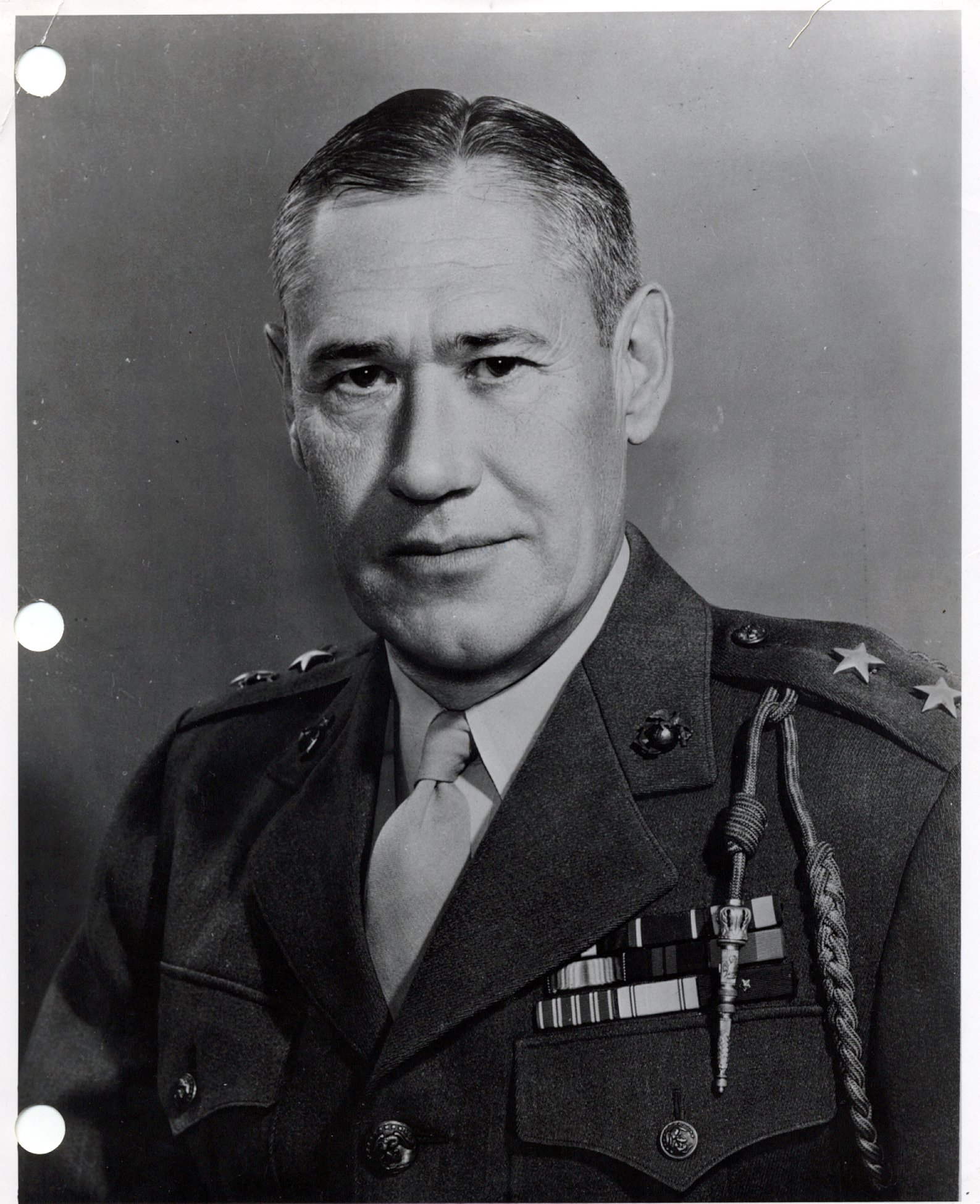
LIEUTENANT GENERAL
KELLER E. ROCKEY, USMC (DECEASED)
Lieutenant General Keller E. Rockey died of a heart attack, 6 June 1970, in Harwich Port, Massachusetts. He was 81. Funeral services with full military honors were held 11 June 1970, at Arlington National Cemetery, Arlington, Virginia. General Rockey commanded the Fifth Marine Division in the battle of Iwo Jima in World War II and the Third Amphibious Corps during the occupation of North China following the war.
For outstanding services with the Third Amphibious Corps, he was awarded the Distinguished Service Medal (Army), and for exceptionally meritorious service with the Fifth Marine Division, he was awarded the Distinguished Service Medal (Navy). The citation for the latter reads in part:
"…in a position of great responsibility as Commanding General of the Fifth Marine Division prior to and during the seizure of enemy-held Iwo Jima from 19 February to 26 March 1945…Major General Rockey skillfully welded the new and untried Division into a formidable fighting command."
"…a bold tactician, he landed his forces at the base of Mount Suribachi. Deploying his units according to plan, he quickly cut the island in two. Directing the assault with superb generalship he moved his forces inexorably forward and captured the mountain. Continuing his attack to the north, he waged furious battle until he had succeeded in annihilating the last pocket of Japanese resistance."
General Rockey was born 22 September 1888, in Columbia City, Indiana. He was a graduate of Gettysburg College with a Bachelor of Science degree, and was a student at Yale University. He was commissioned a second lieutenant in the Marine Corps, 18 November 1913.
His first duty assignment as a Marine Corps junior officer was a student under instruction at the Officers Basic School, Norfolk, Virginia. Following graduation there in May, 1915, he went to sea; first as a member of the Marine Detachment aboard the USS Nebraska, then a member of the Marine Detachment aboard the USSNevada.
Following sea service, he sailed for France in June 1917, and one year later, as a member of the Fifth Marine Regiment, participated in the Aisne-Marne Defensive (Chateau-Thierry).
He was awarded the Navy Cross for his actions at Chateau-Thierry where, on 6 July 1918, he performed distinguished service by bringing up supports and placing them in the front lines at great personal exposure, showing exceptional ability and extraordinary heroism.
He also received the Distinguished Service Cross and was cited in the General Orders of the Second Division, American Expeditionary Forces. He was entitled to wear the French Fourragere.
Shortly after returning to the United States in 1919, General Rockey went to foreign shore duty in Haiti as a member of the Haitian Constabulary, where he remained until 1921, then returned to this country to join Marine Barracks, Washington, D.C.
Following duty at Headquarters Marine Corps, Washington, D.C., he became a student in the Field Officers' Course, Marine Corps Schools, Quantico, Virginia. After graduation in July 1925, he was again assigned to school, this time as a student at the Command and General Staff School, Fort Leavenworth, Kansas. Upon graduation in June 1926, he became an instructor in the Department of Tactics, Marine Corps Schools.
From January to November 1928, he was Commanding Officer, First Battalion, Eleventh Artillery Regiment, Second Marine Brigade, stationed in Nicaragua, where he was awarded a Gold Star in lieu of a second Navy Cross for outstanding services.
The General next became Base Intelligence, Operations and Training Officer of the Marine Corps Base, San Diego, California, and later Chief of Staff of the Base.
In June 1934, he was assigned to duty as Chief of the War Plans Division, Marine Corps Headquarters, following which he became Force Marine Officer, U.S. Battle Force aboard the USS California.
He returned to Washington in July 1939, to assume duties with Operations, Navy Department (War Plans) and in August 1941, became Chief of Staff of the Second Marine Division in which position he was found upon this country's entry into World War II.
General Rockey was assigned duties as Director, Division of Plans and Policies at Headquarters Marine Corps, in August 1942, and one year later assumed duties as Assistant Commandant of the Marine Corps. In February 1944, he went to the Pacific where he was successively Commanding General of the Fifth Marine Division (Iwo Jima) and the Third Amphibious Corps.
Following deactivation of the Third Amphibious Corps, he assumed command of the First Marine Division (Reinforced), with headquarters at Tientsin, China. He returned to the United States and became Commanding General of the Department of the Pacific, San Francisco, California, in September 1946.
On 1 January 1947, he was advanced to lieutenant general (temporary), and the following day assumed command of the Fleet Marine Force, Atlantic with headquarters in Norfolk, Virginia. On 1 July 1949, when he was detached to again become Commanding General, Department of the Pacific, San Francisco, California, he returned to his permanent rank of major general. He retired as a lieutenant general on 1 September 1950.
In addition to the Navy Cross, Gold Star in lieu of a second Navy Cross; Distinguished Service Cross (Army); Distinguished Service Medal (Navy) and Distinguished Service Medal (Army), his decorations and medals include the Presidential Unit Citation, Iwo Jima 1945; Mexican Service Medal, 1916; Victory Medal with Aisne and Defensive Sector Clasps, France, 1918; Haitian Campaign Medal, 1919-1920; Expeditionary Medal, Haiti, 1920-22; Second Nicaraguan Campaign Medal, 1928-29; American Defense Service Medal; Asiatic-Pacific Theater Campaign Medal with two bronze stars; World War II Victory Medal; Nicaraguan Medal of Merit; the Order of the Cloud and Banner, Second Class, China, 1945; and Legion of Honor, France.